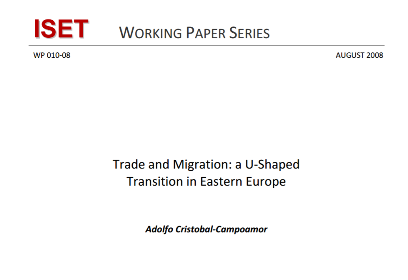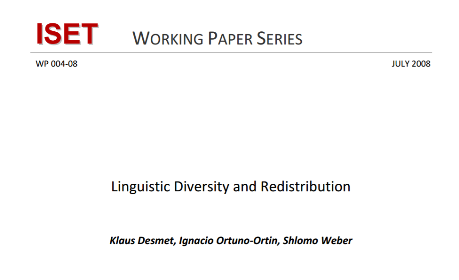Faculty Research
Trade and Migration: a U‐Shaped Transition in Eastern Europe

by Adolfo Cristobal‐Campoamor
This paper proposes a 2-country 3-region economic geography model that can account for the most salient stylized facts experienced by Eastern European transition economies during the 1990s. Read more...
Skill‐Upgrading and the Saving of Immigrants
 by Adolfo Cristobal‐Campoamor
by Adolfo Cristobal‐Campoamor
This note derives positive implications about the effect of immigration on labor income and the skill composition of the labor force in receiving economies. The novel mechanism through which immigration affects labor-market outcomes is the availability of new loanable funds for human-capital investment, which results in endogenous skill upgrading. Given their higher training costs in the host economy, immigrants usually do not acquire advanced academic skills, and they accordingly skip the financial costs of education at the college level. As a result, they self-select as net lenders, which reduces the equilibrium interest rates and facilitates the upgrading mostly of new generations of natives. Consequently, the aggregate labor income of natives increases with immigration. Read more...
International convergence and local divergence

by Adolfo Cristobal‐Campoamor
Published in: The Annals of Regional Science, Volume 43, Issue 2 (2009), page 527;
Abstract: This paper presents an East-West endogenous-growth model that reproduces recent stylized facts applicable to the trade liberalization process of many developing countries: convergence with the rest of the world, higher internal divergence, increasing spatial concentration of economic activity and higher growth rates. Read more...
Estimating Iceland’s Real Equilibrium Exchange Rate

by Robert Tchaidze
Given recent developments in Iceland, this paper evaluates its real exchange rate disequilibrium. It discusses three approaches to estimating the equilibrium values and suggests that the adjustment needed to bring the real exchange rate in line with fundamentals is in the range of 15-25 percent, although timing and manner of this adjustment is unclear. Read more...
The Use and Abuse of Taylor Rules: How Precisely Can We Estimate Them?

by Alina Carare, Robert Tchaidze
This paper draws attention to inconsistencies in estimating simple monetary policy rules and their implications for policy advice. We simulate a macroeconomic model with a backward reaction function similar to Taylor (1993). We estimate different versions of a policy rule, using these simulated data. Read more...
Linguistic Diversity and Redistribution

by Klaus Desmet, Ignacio Ortuño-Ortín, Shlomo Weber
This paper investigates the effect of linguistic diversity on redistribution in a broad cross-section of countries. We use the notion of "linguistic distances" and show that the commonly used fractionalization index, which ignores linguistic distances, yields insignificant results. However, once distances between languages are accounted for, linguistic diversity has both a statistically and economically significant effect on redistribution. With an average level of redistribution of 9.5% of GDP in our data set, an increase by one standard deviation in the degree of diversity lowers redistribution by approximately one percentage point. We also demonstrate that other measures, such as polarization and peripheral heterogeneity, provide similar results when linguistic distances are incorporated. Read more...
Stability of Nations and Genetic Diversity

by Klaus Desmet, Michel Le Breton, Ignacio Ortuño-Ortín, Shlomo Weber
This paper presents a model of nations where culturally heterogeneous agents vote on the optimal level of public spending. Larger nations bene¯t from increasing returns in the provision of public goods, but bear the costs of greater cultural heterogeneity. This tradeo® induces agents' preferences over di®erent geographical con¯gurations, thus determining the likelihood of secession or uni¯cation. We provide empirical support for choosing genetic distances as a proxy of cultural heterogeneity and by using data on genetic distances, we examine the stability of the current map of Europe. We then identify the regions prone to secession and the countries that are more likely to merge. Furthermore, we estimate the welfare gains from European Union membership. Read more...
Trade and Investment Cooperation in East Asia

by Wilfred J. Ethier
This paper attempts to provide a context for the discussion of possible trade and investment cooperation is East Asia. First I describe the present role in the world economy of regional cooperative arrangements. These seem to be concerned primarily with foreign investment, secondarily with national economic-policy credibility, and thirdly with other issues, such as trade and migration. I discuss the changing role of East Asia in the global economy, especially with regard to the role of the multilateral trading system. This changing role raises the issue of possible East Asian cooperation, which I discuss in the light of the present function of regional arrangements. I attempt to identify potential benefits and dangers and the circumstances to which these are sensitive. Read more...
Voting on the Choice of Core Languages in the European Union
 by Jan Fidrmuc, Victor Ginsburgh, Shlomo Weber
by Jan Fidrmuc, Victor Ginsburgh, Shlomo Weber
Published as: Fidrmuc, Jan & Ginsburgh, Victor & Weber, Shlomo, 2009. "Voting on the choice of core languages in the European Union," European Journal of Political Economy 25(1), pages 56-62.
Extensive multilingualism is one of the most important and fundamental principles of the European Union (EU). However, a large number of languages (currently 23) hinders communication and imposes substantial financial and legal costs. On the other hand, the reduction of the number of languages would disenfranchise some or many EU citizens. We use the results of a survey on languages and argue that even though a linguistic reform reducing the number of languages is unlikely to gain sufficient political support today, this may change in the future since young people are more proficient at speaking foreign languages. Read more...
The Greater the Differences, the Greater the Gains?

by Wilfred J. Ethier
This paper addresses the fundamental question of whether, in a comparative-advantage context, the gains from trade will be greater when the differences between trading countries are greater. Such a presumption is established. The paper then discusses circumstances that could cause the presumption to fail. Read more...
CONTACT US
16, Zandukeli St,
0108 Tbilisi,
Georgia
Telephone: (+995 32) 250 71 77
Email: info@iset.ge

